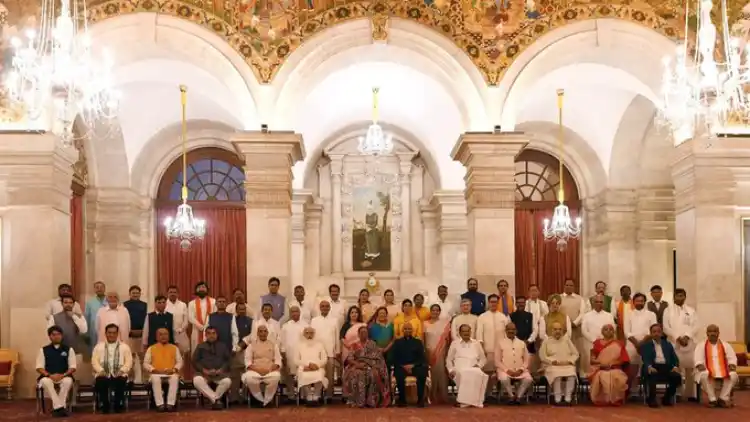
 Sushma Ramachandran
Sushma Ramachandran
The latest mega-cabinet reshuffle has brought in several changes in the crucial economic portfolios, giving a hint towards possible policy shifts in the days to come. The core economic ministries of Finance, Commerce and Industry have remained untouched, ensuring the broad approach will remain the same. But there are a host of ministries handling critical infrastructure areas that have been brought under new administrators. So there is bound to be a shakeup in existing systems.
The clubbing of departments has also been altered significantly. In some cases, the changes make eminent sense while not so much in others. These upheavals need to be viewed carefully given the fact that the economy is in the doldrums as the second Covid surge blunted the rapid recovery at the beginning of this year. Rating agencies as well as the central bank have already scaled down their growth expectations for the current fiscal - 2021-22. So a lot of work needs to be done by the new-look Cabinet before economic revival becomes a reality.
One noteworthy and much-needed change has been the transfer of the Department of Public Enterprises to the Finance Ministry. This gives a clear signal that disinvestment of public enterprises is going to become a priority and that there will be a single point administration in the Finance Ministry. Currently, the department of investment and asset management which handles disinvestment is also with the Ministry, and the addition of DPE will make it easier to carry out privatisation under a single umbrella.
As far as ministerial changes are concerned, the big surprise has been to make a newcomer, Ashwini Vaishnav in charge of a giant portfolio comprising Railways, Communications, Electronics and Information Technology. Surprising because a large segment of the economy is being entrusted to a brand new ministerial face. Railways comprise a major chunk of the country’s infrastructure as well as being one of the biggest employers. Keeping it in good health and at high levels of operating efficiency is a daunting task and ideally, this should have been handled by a single individual.
The second part of his portfolio is equally sizeable with communications, electronics and information technology, the areas with which the Modi government has been seeking to enter the digital age. It is no secret that the digital economy is dear to the heart of Prime Minister Modi. It was due to initiatives of previous minister Ravi Shankar Prasad that the electronics sector made huge strides with India becoming a manufacturing base for mobile phones while the production linked incentive scheme made its debut in this sector. It was the success in electronics that led to its extension to other industries. The challenge for the new incumbent will be to expand on this base and ensure further growth. There are equally daunting challenges in the communications sector including the introduction of 5 G and ensuring a competitive environment.
Vaishnav’s immediate task will be to deal with the ongoing battle with social media giants like Twitter and WhatsApp over compliance with the new IT laws and rules. He appears set to continue this aggressive approach by stressing in initial comments that the tech giants like Twitter will have to conform to Indian laws.
Another strange combination of ministries is health with chemicals and fertilisers. It certainly makes sense to combine health and the pharma sector but fertilisers is clearly out of place in this grouping. The new Health Minister Mansukh Mandaviya will have to handle this new combination at a time when building up health and medical infrastructure is vitally important for the country.
In fact, it would not be an exaggeration to say that right now health is the most important portfolio in the entire government. The vaccination policy as well as trying to monitor Covid infections is a mammoth task before the new minister. It is also crucially linked to the economy as there can be no sustained recovery while Covid continues to rage in the country. It would have been in the fitness of things to allow him to focus more narrowly on health and pharmaceuticals.
The new Petroleum and Urban Affairs Minister Hardeep Puri will also be handling an area that is in the eye of the storm. Global crude prices are rising by the day and domestic fuel prices have touched unprecedented levels of Rs. 100 per litre. The situation is grim for the exchequer which will have to shell out a huge amount of foreign exchange for oil imports. And it is equally sombre in terms of the inflationary impact of domestic oil prices as well as the political fall out just as polls are on the horizon in key states like U.P.
The new incumbent, however, has shown that he can deal with controversy as is clear by the zealous defence of the Central Vista project. His initial comments about raising domestic crude output are encouraging given that the country is currently importing 80 per cent of its needs. In this context, one hopes there is an overhaul of the existing schemes for inviting the private sector for oil and gas exploration. There is also a need to evolve a long term energy policy with a greater focus on natural gas and other clean fuels.
And finally one must mention the addition of the new Cooperation Ministry under the wing of Home Minister Amit Shah. With cooperatives being a state subject, it will be interesting to watch the progress of this new entity. In the past, cooperation has generally been linked to the agriculture ministry given the huge cooperative network in the rural sector. Clearly, a new strategy is on the anvil for the cooperative sector. This can be a positive development if it brings support to the millions who have put their faith in the cooperative movement in the country.
The altered Cabinet has seen sweeping changes in many important economic sectors and it is to be hoped that these will help to revive growth. The top-level shifts come at a time when current economic indicators are not bright with the manufacturing sector showing a downtrend and GST collections are showing a dip. Only the coming days will show whether this new look will ultimately mean a harbinger of brighter days for the economy.
